CLASSIFICATION OF BATHING WATER
Data aggiornamento scheda:
The quality of bathing water is essential for the protection of the health of citizens and plays an important role also in terms of the protection of the natural environment and the economic aspects in the tourism sector. For this reason, specific monitoring is carried out throughout the bathing season. With regard to the bathing season 2024, more than 31,600 samples of seawater and lake were collected and analyzed on a total of over 5,000 km of bathing coast. At municipal level the km of coast are divided into more or less extensive bathing waters, for a total of 5,506 bathing waters. The results of the analysis, in addition to guaranteeing the absence of hygienic health risks during the season, have also allowed to classify the waters. The classification was made using the results of the monitoring carried out during the 2024 bathing season and those of the previous three seasons (2023-2022-2021). At the national level, most of the waters are excellent in the classroom (91%), however, however, there are still critical issues due to the presence of water in the low class (1.1%) and not classifiable (1.1%), for which it is not possible to make a quality judgment because most are newly identified and have not completed the 4-year cycle of monitoring, necessary for classification. Even at the regional level, the percentage of water in the excellent and good classes is the highest.
Ostreopsis ovata concentration
Data aggiornamento scheda:
Ostreopsis cf. ovate it is a potentially toxic Bentonic microalga, now present in most of the Italian coastal regions with blooms that can give rise to human intoxication phenomena and toxic effects on benting marine organisms (states of suffering or mortality). The continuous expansion along the Italian coasts of Ostreopsis cf. ovate , of its blooms and the health, environmental and economic problems associated with it, has led to establish a microalga surveillance monitoring program since 2007. This activity has been carried out annually in the summer season by the regional environment agencies (ARPA). The data provided so far by the ARPA, collected and processed by Ispra have clarified the distribution and performance of the blooms at national and regional level. To date, the microalga has been found at least once in the monitoring campaigns carried out so far in 12 coastal regions out of 15. In 2024, the Ostreopsis CF. Ovata is present in 11 coastal regions or in 147/196 stations (75%), while it is absent in all samples taken along the Coste of Emilia-Romagna, Marche, Molise and Veneto.
ASTRONOMICAL TIDE HEIGHT ALONG ITALIAN COASTS
Data aggiornamento scheda:
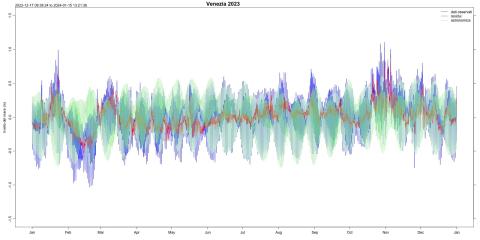
The tide is a periodic phenomenon of rising and falling sea levels caused by the gravitational attraction exerted by the Moon, the Sun, and other celestial bodies on the Earth's water masses, and secondarily by meteorological disturbances. Data from the National Tide Gauge Network (ISPRA) were used to characterize the amplitude of the astronomical component of the tidal signal along Italian coasts. As well known, astronomical tides vary significantly across the different Italian seas, reaching their maximum range in the Northern Adriatic and Venice Lagoon, being strongly influenced by the basin's configuration.
MARINE STRATEGY MONITORING – BEACH LITTER
Data aggiornamento scheda:
The Marine Strategy (Directive 2008/56/EC) represents an important governance tool for the marine system, promoting the adoption of strategies aimed at safeguarding the marine ecosystem to achieve Good Environmental Status. Good Environmental Status is assessed based on 11 themes or qualitative descriptors, and among these, Descriptor 10 requires that the properties and quantities of marine litter do not cause harm to the coastal and marine environment. Since 2015, Italy has been implementing an extensive monitoring program for marine litter, including beach litter. In 2023, the median of total marine litter stranded on Italian shores was 250 items per 100 m, the lowest value in the entire historical series. However, this is still a density significantly higher than the threshold value of 20 items per 100 m, established at the European level as a requirement for achieving Good Environmental Status. As in previous years, single-use plastics are the most common type of beach litter, representing 13% of the total; however, for this type of litter, there is a sharp decline compared to 2022 (29%), which, if confirmed in the coming years, could represent a significant first result of the effectiveness of the Marine Strategy Measures Program and, in particular, the application of Directive 2019/904 for the reduction of single-use plastics.
CLEAN COAST INDEX (CCI)
Data aggiornamento scheda:
Any solid material, manufactured or processed by humans, abandoned or lost in the marine and coastal environment or that reaches the sea in any way is defined as marine litter. Italy, with Legislative Decree No. 190/2010 transposing the Marine Strategy Framework Directive, has been conducting an intensive marine litter monitoring program since 2015, including beach litter. Twice a year, in spring and autumn, the coastal Regional Environmental Protection Agencies (ARPA) carry out monitoring of solid waste present in sample areas of 69 reference beaches along the national coastline. To assess the cleanliness of the beaches based on the density of litter present in the monitored sample areas, the Clean Coast Index (CCI) was calculated, an indicator developed and applied internationally.
In 2023, the CCI was calculated for 69 beaches both in spring and autumn. In spring, 80% of the monitored beaches were clean or very clean compared to 12% of dirty or very dirty beaches. In autumn, 77% of the beaches were clean or very clean, while 12% were dirty or very dirty. The rest of the beaches were fairly clean. Compared to the previous year, the percentage of clean or very clean beaches increased in autumn (75% in 2022), while in spring it remained the same.
EUTROPHICATION
Data aggiornamento scheda:
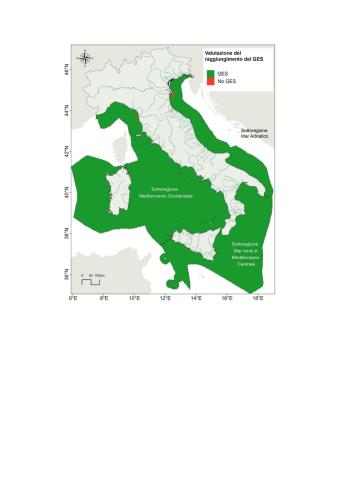
Eutrophication is a process caused by the enrichment of nutrients, particularly nitrogen and phosphorus compounds, which leads to an increase in primary production and algal biomass, resulting in the alteration of benthic communities and, in general, a decline in water quality. The input of nitrogen and phosphorus into the marine and coastal environment can originate from diffuse sources (river loads, major collectors of agricultural activity, and urban discharges) and point sources (discharges from wastewater treatment plants, industrial activities, and aquaculture operations). Objectives related to eutrophication control and management are set by the Water Framework Directive (WFD, Directive 2000/60/EC), the Marine Strategy Framework Directive (Descriptor 5, Directive 2008/56/EC), and the Nitrates Directive (Directive 91/676/EEC) and Urban Waste Water Treatment Directive (Directive 91/271/EEC), which are particularly focused on pressure management. The causes of eutrophication are primarily linked to nutrient inputs carried into the sea by rivers or coastal settlements, which cause serious negative impacts on the health of marine ecosystems and the sustainable use of goods and services. The main sources of nutrients are related to the agri-livestock and urban sectors.
Environmental assessments regarding eutrophication, in accordance with the requirements of Directive 2008/56/EC, have highlighted the achievement of Good Environmental Status. Therefore, the measures adopted so far under Directive 2000/60/EC, Directive 91/676/EEC, and Directive 91/271/EEC have proven effective in achieving environmental targets.
UPWELLING
Data aggiornamento scheda:
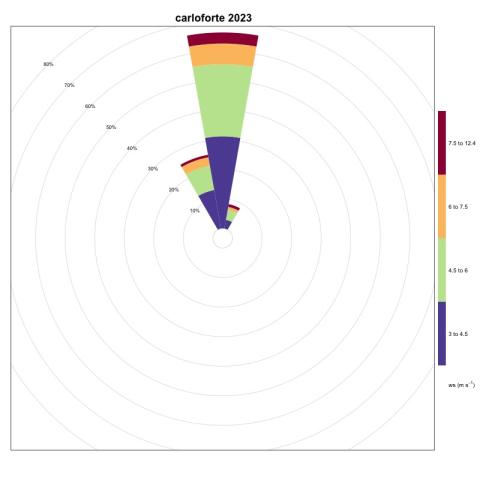
Upwelling is a physical phenomenon caused by the action of wind and currents that can generate an upwelling current, oriented offshore and perpendicular to the coast. This phenomenon has a significant impact on the local fish fauna and is therefore of great interest. The identification of the most favorable areas for the occurrence of this phenomenon has been carried out using wind speed and direction data provided by the National Tide Gauge Network (RMN) managed by ISPRA. These data, appropriately processed, allow the identification of coastal areas that are most likely to be exposed to the upwelling phenomenon, such as the Carloforte area in Sardinia, which is confirmed to be among the most favorable for the generation of this variable.
MARINE STRATEGY MONITORING - ALTERATION OF HYDROGRAPHIC CONDITIONS
Data aggiornamento scheda:

The monitoring provided by the Marine Strategy Framework Directive 2008/56/EC for Descriptor 7 considers the permanent alterations of hydrographic conditions due to coastal and marine infrastructures subject to national EIA, constructed or under construction or design since 2012. The reference indicator for D7C1 relates to the extent of coastal marine water bodies in each marine subregion, defined under Directive 2000/60/EC, which presents impacts due to permanent changes in hydrographic conditions due to new infrastructures constructed since 2012 and subject to national EIA. The objective for this indicator is not to exceed 5% of the extent of coastal marine water bodies. In 2023, the objective was achieved.
MARINE STRATEGY MONITORING - MICRO-LITTER IN THE SURFACE LAYER OF THE WATER COLUMN
Data aggiornamento scheda:

Italy, in application of the Marine Strategy Framework Directive, has implemented an extensive marine litter monitoring program since 2015, including micro-litter present in the surface layer of the water column. This monitoring is conducted by the National System for Environmental Protection (of which ISPRA is a part), under the coordination of the Ministry of Environment and Energy Security (MASE). The composition, quantity, and distribution of surface micro-litter are essential parameters for achieving the good environmental status of marine waters, the objective of the Directive. Micro-litter are particles smaller than 5 mm, whose origin is difficult to identify once dispersed in the environment. These particles derive from both primary sources, such as pellets and microbeads used in cosmetics or abrasive products, and secondary sources, such as the fragmentation of macro-litter. With the data processing carried out from 2016 to 2022, it was possible to define a median density value of micro-particles present in our seas, equal to 0.04 micro-particles per m², or 40,000 micro-particles per km². This value is confirmed by adding the 2023 data to the series. At the Mediterranean level, the Barcelona Convention has set a threshold value of 0.000845 micro-particles per m² (845 micro-particles per km²), therefore, compared to this value, Italy is still far from achieving good environmental status.
MARINE STRATEGY MONITORING – CONTAMINANT CONCENTRATION
Data aggiornamento scheda:

Descriptor 8 of the Marine Strategy Framework Directive 2008/56/EC (MSFD), in order to achieve good environmental status of marine waters through the gradual elimination of pollution, specifically requires the assessment of the presence of chemical contaminants and their effects in environmental matrices. During the 2021–2023 period, ISPRA conducted monitoring of the Adriatic Sea Subregion (MAD), Ionian Sea and Central Mediterranean Subregion (MIC), and Western Mediterranean Subregion (MWE). The data were processed and integrated with those provided by regional agencies and experimental zooprophylactic institutes.
This monitoring revealed that, although the data coverage for the study of contaminant concentrations varied across matrices and subregions, there was an overall improvement. This allowed for the assessment of GES (Good Environmental Status) for the sediment matrix in two MRUs and for the biota matrix in the Adriatic MRU.
MARINE STRATEGY MONITORING - PHYSICAL LOSS
Data aggiornamento scheda:
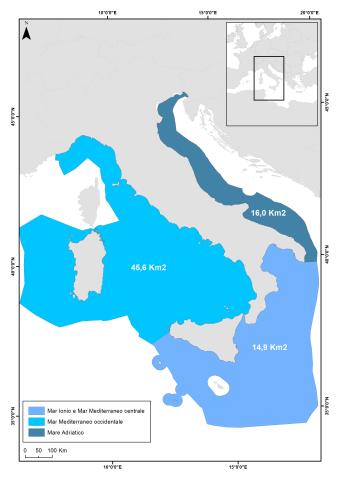
Physical loss defines the surface area of the seabed lost due to permanent modifications of the substrate and/or seabed morphology induced by anthropogenic activities and/or works, such as coastal defense works, port infrastructures, cables and pipelines, etc. It contributes to defining the level of seabed integrity, as defined under the Marine Strategy Framework Directive (2008/56/EC) and Decision (EU) 2017/848; the Directive is based on an integrated approach and aims for Member States to achieve good environmental status (GES) for their marine waters. Physical loss is calculated for the three Marine Reporting Units (MRUs) under Italian jurisdiction: "Adriatic Sea," "Ionian Sea and Central Mediterranean," and "Western Mediterranean Sea." For the initial population of the "physical loss" indicator, data updated to 2021 are used, i.e., the most recent available data for each type of work; these data will constitute the baseline for future populations. The physical loss indicator allows evaluating both the total extent of the studied phenomenon and the incidence of different types of works and/or activities on the total physical loss; it also assesses the incidence and distribution of physical loss in relation to different habitat types (Broad Habitat Types and Other Habitat Types sensu MSFD) present in Italian seas.
COASTAL MARINE WATERS - BIOLOGICAL QUALITY ELEMENT MACROALGAE CARLIT
Data aggiornamento scheda:
In the assessment of the ecological quality of coastal marine environments within the framework of the European Directive 2000/60/EC (implemented through Legislative Decree 152/2006 and subsequent amendments), reference is made to the Biological Quality Element (BQE) Macroalgae. In Italy, as stipulated by Ministerial Decree 260/2010, this BQE is assessed using the CARLIT index (Cartography of littoral and upper-sublittoral benthic communities, or, in short, CARtography of LITtoral), which contributes to the classification of the ecological status of marine-coastal water bodies. For the period 2019–2021, over 80% of analyzed stations met the quality standard (at least "good").
TRANSITIONAL WATERS – BIOLOGICAL QUALITY ELEMENT MACROPHYTES MAQI-TW
Data aggiornamento scheda:
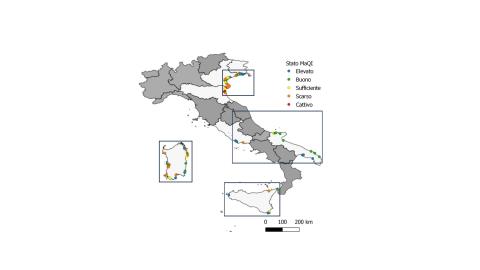
The MaQI (Macrophyte Quality Index) (Sfriso et al., 2014), formally adopted by Italy for the classification of the ecological status of transitional environments under Directive 2000/60/EC, integrates the two biological quality elements: macroalgae and aquatic phanerogams. The MaQI responds to anthropogenic pressures affecting transitional areas and describes the ecological quality status in five classes: high, good, moderate, poor, and bad.
The current monitoring programs in Italian transitional waters provide for two semi-annual samplings within one year of each three-year period. Since 2014, three sampling campaigns have been carried out in almost all regions. In the 2020-2022 three-year period, the MaQI index was applied to 91 Italian transitional water bodies across seven regions. Of these, 23.1% were classified as having a "high" ecological status, 23.1% as "good," 22.0% as "moderate," 28.5% as "poor," and 3.3% as "bad." Nationally, for the regions where data is available (7 out of 9), 46.2% of transitional water bodies met the quality target ("good" or "high").
CHEMICAL STATUS OF COASTAL MARINE WATERS
Data aggiornamento scheda:
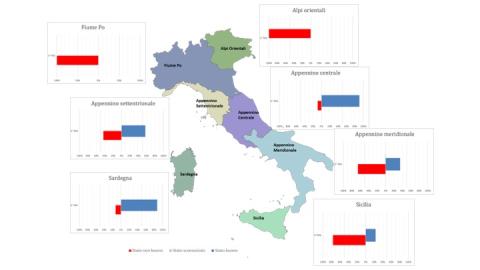
Coastal marine waters are “surface waters located inside an imaginary line, every point of which is one nautical mile seaward from the nearest point of the baseline used to determine the limit of territorial waters, and which may extend up to the outer limit of transitional waters” (Paragraph 1 of Article 74 of Legislative Decree 152/2006). The legislation (Legislative Decree 152/2006) mandates the achievement of a “good” status of water bodies (chemical + ecological) by the dates set by current legislation; failure to achieve environmental objectives results in the implementation of remediation measures. Based on the analysis of data reported by the Districts in the 3rd Reporting to the European Commission for the 2016–2021 six-year period (3rd RBMP), the chemical status of Italian coastal marine waters appears heterogeneous. This heterogeneity is evident both in terms of the number of water bodies identified per district and their classification. The Eastern Alps and Po River Districts have all water bodies in a “not good” chemical status, while in Sicily and the Southern Apennines District, over 60% of the water bodies are in a “not good” status. The Northern Apennines, Central Apennines, and Sardinia Districts, instead, register more than 50%, more than 90%, and more than 80%, respectively, in a “good” chemical status. At the national level, 51% of coastal marine water bodies are in good chemical status. Comparing the 2nd and 3rd RBMPs, in the 2nd RBMP, water bodies with unknown chemical status amounted to 26% (147 out of 561), whereas in the 3rd RBMP, only one water body has an unknown status. Generally, water bodies in good chemical status are comparable between the two RBMPs—52% and 51%, respectively—while water bodies in not good chemical status increased in the 3rd RBMP (49%).
ECOLOGICAL STATUS OF COASTAL MARINE WATERS
Data aggiornamento scheda:
Coastal marine waters are defined as “surface waters situated inside an imaginary line one nautical mile away, at every point, on the outer side from the nearest point of the baseline used to define the territorial sea limit, and potentially extending to the outer boundary of transitional waters.” The legislation (Legislative Decree 152/2006) mandates achieving "good" status (ecological + chemical) for water bodies by the deadlines set by current regulations; failure to meet environmental goals entails remediation measures. Based on the analysis of data reported by Districts in the 3rd Reporting to the European Commission for the six-year period 2016–2021 (3rd WMP), the ecological status of Italian coastal marine waters is heterogeneous. This heterogeneity is expressed in both the number of water bodies identified per district and their ecological classification. The Eastern Alps, Northern Apennines, Central Apennines, Sicily, and Sardinia Districts show a percentage of water bodies in good and high ecological status greater than or equal to 70%. Specifically, in the Sardinia District, more than 40% of water bodies are in high status. Nationally, more than 60% of water bodies (261 out of 394 total) are in good and high ecological status. Comparing data from the 2nd WMP and the 3rd WMP shows that in the 2nd WMP, 27% of water bodies had unknown ecological status (149 out of 561 total), while in the 3rd WMP, only one water body is in unknown ecological status. In general terms, the proportion of water bodies in good and high ecological status increased from 55% in the 2nd WMP to 66% in the 3rd WMP.
COASTAL MARINE WATERS – BIOLOGICAL QUALITY ELEMENT ANGIOSPERMS POSIDONIA OCEANICA PREI INDEX
Data aggiornamento scheda:
In the assessment of the ecological quality of coastal marine environments within the framework of the European Directive 2000/60/EC (transposed by Legislative Decree 152/2006 and subsequent amendments), reference is made to the Biological Quality Element (BQE) Angiosperms. This BQE in Italy, as provided for by the Ministry of the Environment Decree 260/2010, is evaluated through the PREI (Posidonia Rapid Easy Index). In this context, in fact, the meadows of Posidonia oceanica (L.) Delile take on considerable importance in assessing the ecological quality of coastal marine environments, given their wide distribution and sensitivity to sources of disturbance of anthropogenic origin. The classification of this BQE is carried out where, for reasons of geographical distribution, the meadow is present, i.e., in the Tyrrhenian regions and in Apulia. The data analyzed show that more than 80% of the meadows are in "good" or "high" status.
COASTAL MARINE WATERS – BIOLOGICAL QUALITY ELEMENT CHLOROPHYLL a
Data aggiornamento scheda:
The "chlorophyll" parameter is the only direct indicator of phytoplankton biomass available and has taken on the role of a metric for classifying ecological status according to the Biological Quality Element (BQE) – Phytoplankton in coastal waters (Ministerial Decree 260/2010). Chlorophyll is particularly sensitive to changes in trophic levels determined by nutrient (N and P) inputs from catchment basins flowing into the coastal area.
In 2020, high status was recorded in 71.4% of cases, good status in 12.3%, and sufficient status in 16.2%. A general improvement in status was observed in Campania and Marche, while Emilia-Romagna and Sardinia saw a worsening. Marche, Liguria, and Abruzzo maintained all stations at high status.
COASTAL MARINE WATERS - BIOLOGICAL QUALITY ELEMENT BENTHIC MACROINVERTEBRATES M-AMBI-CW
Data aggiornamento scheda:
The ecological classification index of the Biological Quality Element "benthic macroinvertebrates," M-AMBI (Multimetric-AZTI Marine Biotic Index), allows a synecological evaluation of the ecosystem under analysis. It is based on the analysis of the structure of benthic macroinvertebrate communities, considering the ecological value of macrozoobenthic species in soft sediments. Species are divided into five ecological groups (first-order opportunistic, second-order opportunistic, tolerant, sensitive/tolerant, and sensitive) based on their sensitivity to gradients of environmental stress. The index describes the quality status of the Biological Quality Element "benthic macroinvertebrates" in five classes: High, Good, Moderate, Poor, and Bad.
Overall, no critical situations were identified for the period 2017–2022 in the coastal regions where data are available. The analysis indicates that 74% of monitoring stations are in High or Good status, while 1% of stations are in Bad status.
TRANSITIONAL WATERS - BIOLOGICAL QUALITY ELEMENT BENTHIC MACROINVERTEBRATES M-AMBI-TW
Data aggiornamento scheda:
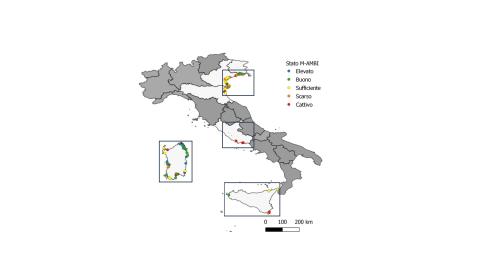
The ecological classification index of the Biological Quality Element "macroinvertebrates" for coastal lagoons, M-AMBI (Multivariate-Azti Marine Biotic Index), is based on the analysis of the structure of the macrozoobenthic community in soft sediments. It takes into account species tolerance/sensitivity, community diversity, and species richness. The M-AMBI index responds to anthropogenic pressures affecting transitional areas and describes the ecological quality status in five classes: High, Good, Moderate, Poor, and Bad.
Currently operational monitoring programs in Italian transitional waters include annual sampling on a three-year cycle: as of now, three sampling campaigns have been conducted in almost all regions since 2014. In the 2020-2022 three-year period, of the 92 transitional water bodies where the M-AMBI index was applied, 14.1% are in "High" ecological status, 32.6% in "Good," 21.7% in "Moderate," 16.3% in "Poor," and 15.2% in "Bad." Nationally, for the regions with available data (6 out of 9), 46.7% of transitional water bodies have achieved the quality goal of "Good" or "High."
CHEMICAL STATUS OF TRANSITIONAL WATERS
Data aggiornamento scheda:

The legislation (Legislative Decree 152/2006) mandates achieving good status of water bodies (chemical + ecological) by the deadlines established by the current legislation. The analysis of chemical status shows heterogeneous values among the districts, with 100% of water bodies in good status only for the Central Apennines and 52% for Sardinia. In all other districts, the percentage of water bodies in good status never exceeds 50% and ranges from 3% in the Eastern Alps to 40% in the Northern Apennines.
A comparison between the status in the 2nd Water Management Plan (WMP) cycle and that in the 3rd cycle shows maintenance of good chemical status for 100% of the water bodies in the Central Apennines, an improvement for those in the Northern Apennines (from 30% to 40%), Sardinia (from 12% to 52%), and Sicily (from 11% to 17%), and a worsening for the water bodies in the Eastern Alps District (from 51% to 3%), Po River (from 65% to 23%), and Southern Apennines (from 18% to 11%).
At the national level, the number of water bodies in good status is 56 out of 172 (33%) in the 2nd WMP cycle, while in the 3rd cycle it is 42 out of 146 (29%).
ECOLOGICAL STATUS OF TRANSITIONAL WATERS
Data aggiornamento scheda:
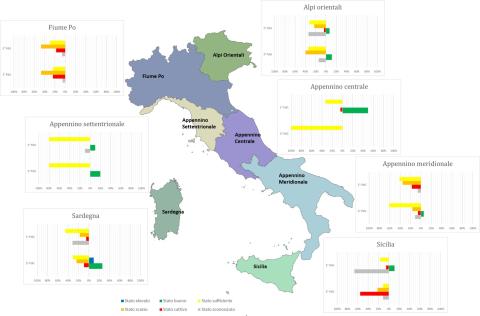
Transitional waters are defined in Legislative Decree 152/2006 as "surface water bodies near a river mouth, partially saline due to their proximity to coastal waters but significantly influenced by freshwater flows." This definition encompasses coastal lagoons and coastal ponds subject to ecological classification. Italian transitional environments are exposed to numerous pressure factors, often leading to degradation of ecological conditions in these fragile ecosystems. The ecological status analysis shows heterogeneous values, both in the number of Water Bodies (WB) and in the distribution across quality classes, with a prevalence of sufficient and poor statuses in all Districts. Comparing the status of the 2nd Water Management Plan (WMP) cycle with that of the 3rd cycle, it is observed that for all hydrographic districts, ecological status remains predominantly sufficient and poor. However, there is an increase in the percentage of water bodies in good status in the Eastern Alps District (from 7% to 11%), Northern Apennines District (from 10% to 20%), Southern Apennines District (from 0% to 6%), and Sardinia District (from 0% to 26%). National analysis of ecological status shows that the number of water bodies in good or high status increased from 9 out of 172 (5%) in the 2nd WMP cycle to 22 out of 146 (15%) in the 3rd cycle.